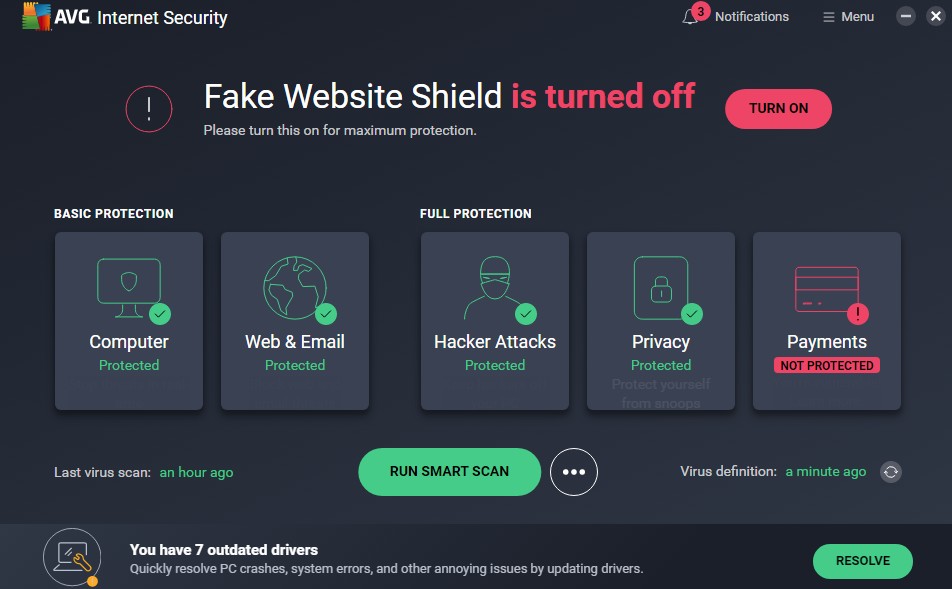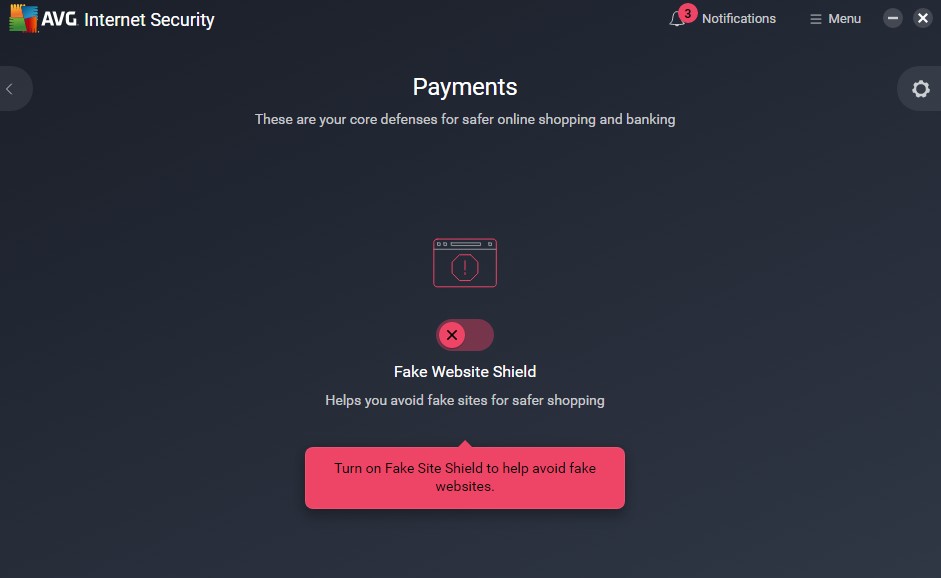I have earlier written lots of articles about VPN services. I know a lot about which VPN to use to access Netflix and other streaming services. But, sometimes I face strange problems. For example, I know that Surfshark gives access to Hulu, but even though I am connected to a server in the United States, I am unable to access Hulu. What is wrong? I know Surfshark is working because I am using it (successfully) on Linux systems and as a browser extension. On both occasions, it works with Hulu. What’s wrong then? Why isn’t Surfshark giving access to Hulu (and other streaming services) when I use the normal Surfshak application in Windows? After some research, I found the problem – the Fake Website Shield of AVG Internet Security.
I have to mention at once that I have experienced the problem above not only with Surfshrk, but also with NordVPN, ExpressVPN, PureVPN, and many other VPN providers. It is annoying because I know that the VPN is supposed to work, but still, I am blocked. I have written shortly about the same phenomenon earlier in this article.
A little description of the problem.
Let us say that I want to watch Swedish Netflix with Surfshark. I start the Surfshark application and connect to a server in Sweden. I open my browser and I enter www.netflix.com in the address field. But, instead of seeing the actual content on Swedish Netflix, I see only the international Netflix content for which they have worldwide broadcasting rights. This is what I often refer to as a limited Netflix version.
Then I start my Linux computer running with the Ubuntu operating system. I connect to the same Surfshark server in Sweden and do the same. Guess what? Now I can watch both the local Swedish content and the international content.
Then I return to my Windows computer and I connect to the Surfshark server in Sweden with the browser extension. Once again I get full access to the entire Swedish Netflix catalog.
What is the difference between the three instances? To me, it was AVG Internet Security and the Fake Website Shield.
How did AVG Internet Security and the Fake Website Shield cause this problem?
I know AVG caused this problem because in the moment I disabled AVG Internet Security, I could watch Swedish Netflix using the normal Surfshark desktop application. But, to find out exactly which part of AVG Internet Security caused this problem, I disabled parts of the protection, step-by-step. That is when I discovered that the Fake Website Shield was the troublemaker.
I then looked up the exact purpose of the Fake Website Shield and I quickly understood why it caused the trouble.,
Fake Website Shield is available in the latest version of AVG Internet Security and protects you against DNS (Domain Name System) hijacking to ensure you get to the actual website you want to visit. This feature is designed to require minimal input from you. To ensure you are protected, all you need to do is keep Fake Website Shield enabled.
Every time you enter the URL (web address) of a website, such as www.example.com, into the address bar of your browser, the URL is translated to the IP address (Internet Protocol address) of the web server where the web page that you want to access is stored. Fake Website Shield provides an encrypted connection between your web browser and AVG’s own DNS server to prevent hijacking and ensure that the displayed website is the authentic one.
Fake Website Shield (AVG)
What really happened?
It worked in Ubuntu because AVG wasn’t running. It worked well with the browser extension because it overrode the AVG browser settings. But, why didn’t it work with the desktop application? The problem occurred because AVG Internet Security overrode the VPN DNS settings.
Surfshark customers use the DNS servers of Surfshark. If AVG notices that something doesn’t seem entirely correct, they automatically override the DNS settings and “solve the problem.” This is very good for general protection and against phishing attacks and more. But, when it comes to unblocking Netflix and other streaming services, it isn’t ideal.
If we approach this from a technical view, this is what is happening.
When you type www.netflix.com in your browser, you are doing an actual DNS request. A domain name is made to make it easier to remember addresses, compared to remembering the IP addresses of the servers you are interested in. To find the IP address of the server hosting www.netflix.com, you make a DNS request to find this information. At first, the request is sent to your router, then to the DNS server of your ISP, then to the next DNS server, before you get the authoritative IP address of www.netflix.com.
Netflix is a little bit more complicated example than a normal domain, knowing that Netflix operates with lots of servers and IP addresses, in order to serve millions of requests from around the world simultaneously.
While you will get the same IP address as a result whenever you do a DNS lookup on www.ipaddressguide.org, you will not get the same result for all DNS lookup requests for www.netflix.com. The results also depend on your location, as you are normally served by a server close to your location.
Why is Fake Website Shield reacting when I use a VPN with built-in DNS servers?
When you send a request to www.netflix.com, it is normally going through approximately 10 servers or more before you get a final answer about the IP address. This is a process well-known to AVG Internet Security as well. But, when you use Surfshark (or other VPN providers with built-in DNS service), the entire process consists of ONE stop. Why is that?
Your VPN is set up to make all DNS requests to the DNS server of the VPN. This is the first place it will look for an answer and that is where the definite answer to such a request is given (if the VPN/DNS has an authoritative answer for that request). If it doesn’t, it will send you to other name servers for further information. But, since Surfshark and others have definitive answers for www.netflix.com, the first request is the only request that has to be made.
This is causing the Fake Website Shield from AVG to make changes. Even though you are taken to a real Netflix server with the IP address provided by Surfshark, it doesn’t happen the way AVG wants it to happen. As a result, they override the DNS settings from Surfshark and this ruins what the VPN was supposed to fix. This is supposed to be for your protection, but here it is rather ruining the fun.
Do you have to disable the fake website shield for the VPN to work properly?
I wouldn’t start with disabling it, after all, it is a great tool. You should rather open your AVG application, go to Settings, and choose exceptions. There you can add the URLs that you are interested in. You can see my example below used to enjoy the benefits of my VPN without disabling the Fake Website Shield protection entirely.
Whenever I visit hulu.com or netflix.com, I will use the DNS information provided by my provider (in this case, the VPN provider). As a result, AVG will not interrupt and change the DNS servers as I visit those domains.
The Fake Website Shield is a great idea…
I am a big fan of the fake website shield of AVG. After all, phishers are experts at stealing your data, and DNS highjacking is a popular way of doing it. In such cases, they take control of your DNS servers. When you send a request to www.hulu.com, you ask the given DNS server for the IP address of the site. The hackers then point the domain www.hulu.com to their own site and server. Here they often copy the content of www.hulu.com entirely. As a consequence, you believe that you are at the real site when the truth is that you are at a scam site. As you enter your account information and data, all the information is landing in the hands of the hackers.
It is against such attacks that the Fake Website Shield is fantastic. Of course, it would be cool if you received some sort of alert when the fake website shield actually did something (not just having it work in the background). But, all in all, it is a great product!
I hope this article has given some clarity on the subject of VPNs and AVG Internet Security, and how they might disturb one another. It might be that other antivirus programs and malware scanners will cause similar problems, so hopefully, you will manage to relate to the content of this article, even if you don’t use AVG Internet Security yourself.
Do you have any comments or questions? Write a comment below!


